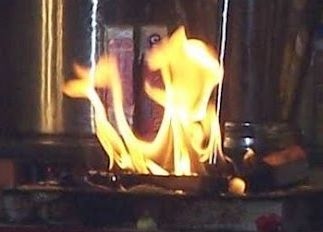- bodhāyanokta -- the shorter version codified by bodhāyana
- rāvaṇokta -- the longer version codified by rāvaṇa
Here is an outline of the mahānyāsa
- pañcāṅga rudra nyāsaḥ (rāvaṇokta)
- pañca mukha nyāsaḥ (rāvaṇokta)
- keśādi pādānta nyāsaḥ
- daśāṅga nyāsaḥ
- pañcāṅga nyāsaḥ
- haṁsa gāyatrī
- dik saṁpuṭa nyāsaḥ
- ṣoḍaśāṅga raudrīkaraṇam
- prārthanā
- guhyādi mastakānta ṣaḍaṅga nyāsaḥ
- ātma rakṣā
- śiva saṁkalpaḥ
- puruṣa sūktam
- uttara nārāyaṇam
- apratirathaḥ
- pratipūruṣam
- śatarudrīyam
- pañcāṅga japaḥ
- aṣṭāñga praṇāmaḥ
- laghunyāsaḥ
Notes:
- The pañcāṅga rudra nyāsa and pañca mukha nyāsa are only found in the rāvaṇokta version.
- Many of the nyāsas feature "saṁpuṭīkaraṇam", where they are enclosed by bījas, or with the "namah śambhave ca mayobhave ..." mantras. In some traditions, "saṁpuṭīkaraṇam" is taken to be the añjali-mudrā. As a result, only the core mantras are chanted.
- There are two passages for the śatarudrīyam, one from the taittirīya saṁhitā, and another from the taittirīya brāhmaṇa. Both of them start with the same mantra. The brāhmaṇa portion is chanted everywhere. Some traditions also include the saṁhitā version.
- The śiva saṁkalpa is a mix of mantras and ślokas. Some of the mantras are taken from the śukla yajur veda, though many traditions seem to have changed the svaras. This section has the greatest amount of variation -- in the wording of the ślokas, the svaras, and their ordering.
- There are two different versions of the pañcāṅga japa.
In general, there is a trend towards a "longer is better" mentality. However, it is sometimes better to stick to the shorter core pāṭha of the mahānyāsa.

